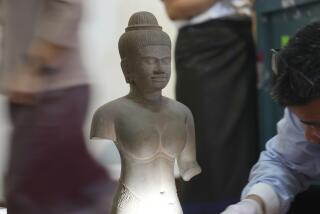Tracing Myanmar’s tragedy, glamour
- Share via
YANGON, Myanmar — At a trio of quirky museums in Yangon, glittering gems, dusty glamour photos and the relics of an independence martyr help illustrate past and present of this stunning but tragic Southeast Asian nation.
Just east of the soaring Shwedagon Pagoda, the crown jewel of sightseeing in the capital, sits the Bogyoke Aung San Museum. A secluded 1920s house perched like a haunted Victorian mansion on top of a large hill, the former home of Burma’s independence leader remains mostly intact, offering a look back at a country that regularly erases its history.
Gen. Aung San led the movement to free Myanmar, also known as Burma, from its British colonial masters shortly after World War II and then pushed for democracy. He was assassinated months before Myanmar’s 1948 independence. His daughter, Suu Kyi, who would later follow in her martyred father’s pro-democracy footsteps, was just 2.
Suu Kyi has become an international symbol of Myanmar, but it’s hard to find much evidence of her in Yangon, also known as Rangoon, today. Myanmar’s ruling military junta has held the Nobel laureate under tight house arrest for 10 of the last 14 years.
Since tourists can’t visit Suu Kyi’s house, which has become a prison rather than a museum, those hoping to learn more about Myanmar’s most famous family head to her father’s. To get there, visitors must hike up a steep, long driveway, guarded by gun-toting soldiers.
Faded black-and-white family photos line cracked walls. Original carved-wood furnishings decorate every room. Smudged glass covers the general’s bookcase holding several English-language works, including Adam Smith’s “The Wealth of Nations.”
Nearby, in the same upper-class neighborhood is the curiously compelling Myanmar Motion Picture Museum. This state-run museum clearly doesn’t get many visitors, as can be seen by the dust-covered floors and cobwebs that connect various pieces of archaic film equipment.
Some signs labeling photos, sets and artifacts of a once developing film industry are translated into English, but this museum leaves a lot up to the non-Burmese speaker’s imagination. There are no English-speaking guides or brochures.
There was clearly a heyday in Burmese film. The museum displays an English-language newspaper article describing the country’s first silent film, “Love and Liquor,” screened in Rangoon in 1920. Several production houses opened in the 1930s and by the 1940s, hundreds of movies were released, some even translated and exported. But like much else in Myanmar, the film industry declined as the military took control in the early 1960s.
Today, the junta heavily controls the industry. Plots are pro-military or politically neutral. Though the films are made on comparatively low budgets, the crowds outside the rather long row of movie theaters in downtown Yangon show that contemporary films are popular.
The museum displays photos of what seems like every winner of the Myanmar Oscar clutching gold statuettes. Spooky, life-size cutouts of movie characters lurk behind models of film sets. Film clips are shown on old TV sets.
For an export sector better known than Burmese films, there’s the Myanmar Gems Museum. The impoverished country is rich in natural resources, its gem and mineral trade generating millions for the military government. Exhibits include a foot-tall jade golfer swinging at a pearl ball, and large piles of rough rubies in countless shades of reds and pinks. The museum boasts the world’s largest sapphire -- 63,000 carats -- resting next to hunks of asbestos and iron ore. Gems are displayed in cases of teakwood.
There’s also a large map of the country with hundreds of tiny colored Christmas lights marking the locations of mines. When you press the button marked “rubies,” red lights illuminate across the north. “Diamond” switches on bright white lights.
The map offers a probably unintended political lesson. It’s hard to miss that many of Myanmar’s most precious stones are found in the northern Shan and Kachin states, where the military government has been brutally fighting ethnic separatist groups for decades.
It’s jarring to think about the alleged human rights violations and harsh conditions that Myanmar’s miners face while one gazes at a dining table fully set in jade.
More to Read
Sign up for The Wild
We’ll help you find the best places to hike, bike and run, as well as the perfect silent spots for meditation and yoga.
You may occasionally receive promotional content from the Los Angeles Times.






